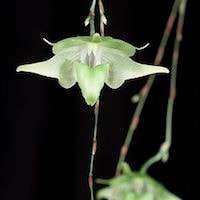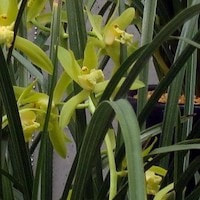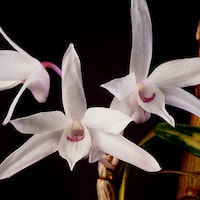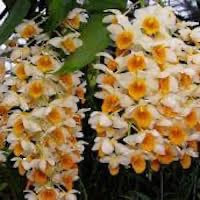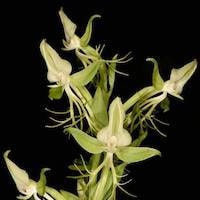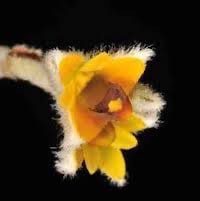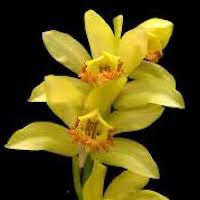Elevate Your Senses with Floral 7 Fragrance Oil
Orchids are known for their captivating scents and diverse fragrance profiles. Several orchid species contribute their distinct scent notes to perfume compositions, each with its own unique characteristics and traditional uses.
One such orchid is Aeranthes Grandalena, a hybrid of Angraecum Magdalenae and Aeranthes Grandiflora. It is utilized in Floral 7 (Women) for a team-building perfume workshop. This hybrid combines the fragrance traits of its parent plants, resulting in a captivating blend of Jasmine from Angraecum and the enticing aroma of butterscotch from Aeranthes.
Cymbidium faberi Rolfe, commonly known as Jiuhua Lan in Chinese, is found in China, Taiwan, Nepal, Bhutan, and northeast India. In traditional herbal practices, the pseudobulbs of Cymbidium faberi are collected in autumn and utilized for various purposes. The root, known for its bitter, sweet, and slightly poisonous properties, is used to alleviate headaches, coughs, and combat insects, worms, and lice. It is also believed to have positive effects on bowel health.
Dendrobium moniliforme, also known as Shihu or Noble Orchid in Chinese, has a long history of medicinal usage. It is highly esteemed in traditional medicine for its ability to regulate body heat, relieve symptoms like haemoptysis and thirst, and improve bodily fluids. Japanese and Korean herbal practices employ Dendrobium moniliforme to address conditions such as night sweats, weakness, anorexia, lumbago, and impotence. Its bioactive compounds, including denbinobin and moniliformedequinone, show promise in antitumor and cytotoxic activities, making it an intriguing subject for cancer research.
Dendrobium thyrsiflorum B.S. Williams is a visually stunning orchid species that produces long clusters of flowers. Phytochemical studies have identified coumarins with bacteriostatic and fungistatic properties in this species. In traditional herbal usage, Dendrobium thyrsiflorum is employed to nourish yin, alleviate heat, and benefit the stomach while promoting the production of body fluids.
The variable species Habenaria arietina Hook f., also known as the Reindeer Orchid, is distributed across multiple Asian countries. It has a wide range of applications in Ayurvedic medicine, including nourishing yin, alleviating heat, and promoting overall well-being. Its traditional uses align with those of Habenaria edgeworthii.
Mycaranthes pannea, known as Zhiyemao Lan in Chinese, possesses medicinal properties in various regions. It is employed in Malaysia, Thailand, and India to alleviate bone aches, ague, and pain associated with dislocated joints. In southern China, it is utilized to improve blood circulation, treat external injuries, fractures, lower back or leg pain, carbuncles, and burns. Additionally, it is considered an antidote for certain plant and substance poisonings.
Phaius flavus is another orchid species found across multiple Asian countries. In Taiwanese herbal medicine, the stems of Phaius flavus are believed to possess antipyretic properties and the ability to detoxify the body. They are commonly used to treat sores and mouth ulcers.
Apart from these orchid notes, perfume compositions may incorporate other scent notes such as cactus flower, champak, costus, daisy, wisteria, wallflower, ylang-ylang, Taif rose, and more. These additional aromatic elements contribute complexity and depth to the perfumes, creating a unique olfactory experience for individuals.
One such orchid is Aeranthes Grandalena, a hybrid of Angraecum Magdalenae and Aeranthes Grandiflora. It is utilized in Floral 7 (Women) for a team-building perfume workshop. This hybrid combines the fragrance traits of its parent plants, resulting in a captivating blend of Jasmine from Angraecum and the enticing aroma of butterscotch from Aeranthes.
Cymbidium faberi Rolfe, commonly known as Jiuhua Lan in Chinese, is found in China, Taiwan, Nepal, Bhutan, and northeast India. In traditional herbal practices, the pseudobulbs of Cymbidium faberi are collected in autumn and utilized for various purposes. The root, known for its bitter, sweet, and slightly poisonous properties, is used to alleviate headaches, coughs, and combat insects, worms, and lice. It is also believed to have positive effects on bowel health.
Dendrobium moniliforme, also known as Shihu or Noble Orchid in Chinese, has a long history of medicinal usage. It is highly esteemed in traditional medicine for its ability to regulate body heat, relieve symptoms like haemoptysis and thirst, and improve bodily fluids. Japanese and Korean herbal practices employ Dendrobium moniliforme to address conditions such as night sweats, weakness, anorexia, lumbago, and impotence. Its bioactive compounds, including denbinobin and moniliformedequinone, show promise in antitumor and cytotoxic activities, making it an intriguing subject for cancer research.
Dendrobium thyrsiflorum B.S. Williams is a visually stunning orchid species that produces long clusters of flowers. Phytochemical studies have identified coumarins with bacteriostatic and fungistatic properties in this species. In traditional herbal usage, Dendrobium thyrsiflorum is employed to nourish yin, alleviate heat, and benefit the stomach while promoting the production of body fluids.
The variable species Habenaria arietina Hook f., also known as the Reindeer Orchid, is distributed across multiple Asian countries. It has a wide range of applications in Ayurvedic medicine, including nourishing yin, alleviating heat, and promoting overall well-being. Its traditional uses align with those of Habenaria edgeworthii.
Mycaranthes pannea, known as Zhiyemao Lan in Chinese, possesses medicinal properties in various regions. It is employed in Malaysia, Thailand, and India to alleviate bone aches, ague, and pain associated with dislocated joints. In southern China, it is utilized to improve blood circulation, treat external injuries, fractures, lower back or leg pain, carbuncles, and burns. Additionally, it is considered an antidote for certain plant and substance poisonings.
Phaius flavus is another orchid species found across multiple Asian countries. In Taiwanese herbal medicine, the stems of Phaius flavus are believed to possess antipyretic properties and the ability to detoxify the body. They are commonly used to treat sores and mouth ulcers.
Apart from these orchid notes, perfume compositions may incorporate other scent notes such as cactus flower, champak, costus, daisy, wisteria, wallflower, ylang-ylang, Taif rose, and more. These additional aromatic elements contribute complexity and depth to the perfumes, creating a unique olfactory experience for individuals.
Download the guided mediation that works best with this Orchid fragrance oil
| women_floral_essential_oil_orchi_00007.mp3 | |
| File Size: | 114365 kb |
| File Type: | mp3 |
The Power of Orchids Unleashed
Contains Scented Notes of following in various proportions:
Native Singaporean Orchid notes: Aeranthes Grandalena
|
Aeranthes Grandalena - Used in Floral 7 (Women) for Team building Perfume workshop
Aeranthes Grandalena is a hybrid orchid resulting from the crossbreeding of Angraecum Magdalenae and Aeranthes Grandiflora. Although it is a non-native species, it has been included in the perfume mix of Floral 7 (Women) for a team-building perfume workshop due to its exceptional qualities. This hybrid combines the desirable traits inherited from both parent plants. Angraecum Magdalenae is known for its enchanting scent reminiscent of Jasmine, while Aeranthes Grandiflora emits a delightful aroma of butterscotch. The combination of these fragrances in Aeranthes Grandalena creates a captivating blend that encapsulates the best of both worlds. Not only does it retain the alluring Jasmine-like notes, but it also adds a touch of delectable butterscotch fragrance to the mix. The result is an exquisite scent that offers a harmonious balance between the floral allure of Jasmine and the sweet, creamy aroma of butterscotch. Aeranthes Grandalena truly embodies the essence of these two parent plants while also offering additional layers of complexity and depth to the fragrance composition. The inclusion of this hybrid in Floral 7 (Women) adds a unique olfactory experience, captivating the senses with its enchanting blend of scents. |
Therapeutic Orchid notes:
|
Cymbidium faberi Rolfe
Chinese names: Jiuhua Lan (nine flower orchid), Yijingjiuhua (nine splendour flower), Tubaibu (wild hundred steps); Taiwanyijingjiuhua (Taiwan Jiuhua blossom), Hui Lan (pure heart orchid), Changye Lan (long leaf orchid), Huaqi Lan (clearing gas orchid) . In Taiwan: multi-flowered orchid Medicinal name: hua qi lan Cymbidium faberi Rolfe, commonly known as Jiuhua Lan or nine-flower orchid in Chinese, is a species of orchid that can be found in various regions, including south of the Yellow River in China, Taiwan, Nepal, Bhutan, and northeast India. It holds several Chinese names such as Yijingjiuhua (nine splendour flower), Tubaibu (wild hundred steps), Taiwanyijingjiuhua (Taiwan Jiuhua blossom), Hui Lan (pure heart orchid), Changye Lan (long leaf orchid), and Huaqi Lan (clearing gas orchid). In Taiwan, it is referred to as the multi-flowered orchid. In traditional herbal usage, Cymbidium faberi is collected during the autumn season. After the collection, the leaves and roots are removed from the pseudobulbs, which are then sun-dried for storage. The root of this orchid species is characterized by its bitter, sweet, mild, and slightly poisonous properties. It is commonly utilized to alleviate headaches or coughs and as an insecticide to eliminate insects, worms, and lice. For the relief of headaches, a decoction of Cymbidium faberi is prepared and consumed. Additionally, a decoction of 6 grams mixed with white wine can be consumed once a day to relieve coughs. Furthermore, for the purpose of eliminating roundworms (ascarids) from the bowels, a mixture of 500 grams of Cymbidium faberi powder and wheat powder is made into buns, which are consumed over a period of three days. These traditional herbal uses of Cymbidium faberi highlight its medicinal properties and its role in traditional Chinese medicine. The various applications, ranging from headache relief to addressing digestive issues, showcase the versatile nature of this orchid species in traditional herbal remedies. |
|
Dendrobium moniliforme (L.) Sw. syn. Dendrobium candidum Wallich ex Lindl., Dendrobium wilsonii Rolfe
Chinese name: Shihu (Noble Orchid), Shilan (stone orchid), Xijingshihu (thin-stemmed Dendrobium), Xiaoshihu (small Dendrobium), Xiaohuancao (small whorled herb), Jizhua Lan (chicken claw orchid), Jingchacao Tongpi Lan (copper orchid), Tongpishihu (copper Dendrobium) Medicinal names: Shihu, Huan cao (whorled herb), (gold hairpin grass), Erhuancao (ear- ring herb), Xicao (slender herb), Huangcao (yellow herb), Xihuancao (slender whorled herb), Xiaojingcha (small gold hairpin) Taiwanese names: Bai Shi Hu (white Dendrobium), Shi Hu (medicinal Dendrobium), Jie Gu Cao (fixing fracture Dendrobium) Japanese name: Sekkoku Korean name: Seok gok It was developed into a highly desirable ornamental plant in Japan during the early part of the nineteenth century. Dendrobium moniliforme, also known as Shihu or Noble Orchid in Chinese, is a highly esteemed orchid species with various names across different cultures. In Chinese, it is referred to as Shilan (stone orchid), Xijingshihu (thin-stemmed Dendrobium), Xiaoshihu (small Dendrobium), Xiaohuancao (small whorled herb), Jizhua Lan (chicken claw orchid), Jingchacao Tongpi Lan (copper orchid), and Tongpishihu (copper Dendrobium). Medicinally, it is known by names such as Huan cao (whorled herb), Huangcao (yellow herb), Erhuancao (earring herb), Xicao (slender herb), Xihuancao (slender whorled herb), and Xiaojingcha (small gold hairpin). In Taiwan, it is called Bai Shi Hu (white Dendrobium), Shi Hu (medicinal Dendrobium), and Jie Gu Cao (fixing fracture Dendrobium). It is known as Sekkoku in Japanese and Seok gok in Korean. During the early nineteenth century, Dendrobium moniliforme gained popularity as an ornamental plant in Japan. It is highly valued for its exquisite beauty and unique characteristics. Phytochemical analysis has identified denbinobin as the most significant compound found in Dendrobium moniliforme. Denbinobin possesses remarkable anti-tumor activity and has shown effectiveness against the AIDS virus. Another promising compound is moniliformedequinone, which exhibits potent cytotoxic activity against hormone-resistant prostate cancer cells in laboratory studies. It induces cellular glutathione depletion, leading to DNA damage response and cell-cycle arrest at the S-phase, ultimately preventing cell multiplication. Additionally, Dendrobium moniliforme has been found to improve immunological function, both in materials obtained from the wild and those cultivated. In traditional herbal usage, Dendrobium moniliforme, known as the classic Shihu and considered the most expensive variety, has been recognized for its medicinal properties. It is used to correct body heat, alleviate symptoms such as haemoptysis, thirst, malaise, and anorexia, and improve overall body fluids. Japanese and Korean herbalists employ it to treat night sweats, weakness, anorexia, lumbago, and impotence. Furthermore, it has been observed to inhibit the release of histamine and aldose reductase, which are relevant in various physiological processes. The multifaceted applications and medicinal benefits of Dendrobium moniliforme demonstrate its significance in traditional medicine and its potential as a source of therapeutic compounds. |
|
Dendrobium thyrsiflorum B.S. Williams
Chinese herbal name: Huangcao shihu Vietnamese name: Thuy tien vang Thai names: Uang mon khai liam, Uang mon khai luang Dendrobium thyrsiflorum, also known as Huangcao shihu in Chinese, Thuy tien vang in Vietnamese, and Uang mon khai liam and Uang mon khai luang in Thai, is a captivating Dendrobium species that produces long clusters of flowers. Phytochemical analysis of Dendrobium thyrsiflorum has identified the presence of coumarins, which are primarily located in the vascular bundles and on the walls of outer fiber cells, with the highest concentration towards the apex of the stem. These coumarins contribute to the plant's chemical composition and are associated with its aromatic properties. Studies have revealed that Dendrobium thyrsiflorum exhibits bacteriostatic/bactericidal and fungistatic/fungicidal properties against certain pathogenic organisms. Remarkably, its bactericidal activity has been found to be even stronger than that of the commonly used antibiotic, ampicillin. These findings highlight the potential antimicrobial properties of Dendrobium thyrsiflorum. In traditional herbal usage, Huangcao shihu is known for its ability to nourish yin and remove heat from the body. It is believed to have a positive impact on the stomach and promotes the production of body fluids. The herb is used to support overall well-being and balance in the body. The beautiful Dendrobium thyrsiflorum, with its long clusters of flowers and its beneficial properties, holds significance both in traditional medicine and as a visually stunning ornamental plant. Its phytochemical composition and potential antimicrobial effects make it an intriguing subject for further research and exploration. |
|
Habenaria arietina Hook. f. Syn. Habenaria intermedia D. Don. var. arietina
Common name: Reindeer Orchid Chinese name: Mao ban yu feng hua Indian Ayurvedic names: Riddhi, Vriddhi, Laksmi, Mangala, Rathanga, Risisrista, Saravajanpriya, Siddhi, Sukha, Vasu, Yuga. (Note that the Ayurvedic names are identical with those of H. edgeworthii.) Other Indian name: Safed musli (in Garhwal), Dakshinavarta, Himadrija. (Note: Similar Ayurvedic names for Habenaria edgeworthii.) Nepali name: Thunma Pakistani common name: reindeer orchid Habenaria arietina, commonly known as the Reindeer Orchid, is a variable species found in various regions including temperate Pakistan, northeast India, Bhutan, Nepal, Bangladesh, China, Thailand, and Vietnam. It is known by different names in different cultures, such as Mao ban yu feng hua in Chinese, and has several Indian Ayurvedic names including Riddhi, Vriddhi, Laksmi, Mangala, Rathanga, Risisrista, Saravajanpriya, Siddhi, Sukha, Vasu, and Yuga. In Garhwal, it is also referred to as Safed musli, and in Pakistan, it is commonly known as the reindeer orchid. The Reindeer Orchid is a fascinating species known for its variability in characteristics. It displays a range of forms and traits within its distribution range. It thrives in temperate regions and can be found growing in diverse habitats across the mentioned countries. In Ayurvedic medicine, Habenaria arietina shares identical names with Habenaria edgeworthii, another species of Habenaria. These names include Riddhi, Vriddhi, Laksmi, Mangala, Rathanga, Risisrista, Saravajanpriya, Siddhi, Sukha, Vasu, and Yuga. This suggests that the two species may possess similar medicinal properties and are associated with auspicious and beneficial qualities according to Ayurvedic traditions. The Nepali name for Habenaria arietina is Thunma, while in Pakistan, it is known as the reindeer orchid, highlighting its presence in these regions and the recognition it holds in the local cultures. The Reindeer Orchid's widespread distribution across various countries and its significance in Ayurvedic and local traditional practices reflect its importance in traditional medicine and cultural contexts. Further research may uncover additional information about its medicinal properties, cultural uses, and potential benefits to human health. |
|
Mycaranthes pannea (Lindl.) S. C. Chen and J. J. Wood Syn.: Eria pannea Lindl.
Chinese name: Zhiyemao Lan (finger leaf hairy orchid), Zhiyenimaolan Chinese medicinal name: Shucong Malay name: Kura kubong Thai name: Phrom hom mai Mycaranthes pannea, also known as Zhiyemao Lan (finger leaf hairy orchid) in Chinese, is a species of orchid with small pseudobulbs and leaves. However, its running rhizomes can stretch for several meters, completely covering the branches of large trees. It has various names in different languages, including Zhiyenimaolan in Chinese, Shucong in Chinese medicinal usage, Kura kubong in Malay, and Phrom hom mai in Thai. In traditional herbal practices, Mycaranthes pannea is used for its medicinal properties. In Peninsular Malaysia, Thailand, and India, the plant is boiled to create a decoction that is used for bathing. This decoction is believed to provide relief from bone aches and ague, which refers to an unremitting fever or malaria. The Kampti tribe in the Lohit community of Arunachal Pradesh utilizes fresh leaves of the plant, making them into a paste that is applied to dislocated joints to alleviate pain and swelling. Similar traditional usage of Mycaranthes pannea is observed in southern China. Known as Shucong in Chinese medicinal practices, it is used to improve blood circulation and for detoxification purposes. It is believed to have properties that can address external injuries, fractures, lower back or leg pain, carbuncles, and burns. Additionally, it is used as an antidote for poisoning caused by poisonous plants such as Coriaria sinica, Aconitum carmichaelii, Gelsemium elegans, Corydalis incisa (Duan Chang Cao), as well as substances like phosphorus and zinc. The traditional uses of Mycaranthes pannea in various regions reflect the cultural significance and traditional knowledge associated with this orchid species. While further scientific research may be needed to validate these traditional uses and explore its chemical constituents, it has been valued for its potential in promoting well-being, relieving pain, and addressing specific health concerns in traditional practices. |
|
Phaius flavus (Blume) Lindl.
Chinese names: Huanghe Lan (yellow crane orchid), Huanghuaheding Lan (yellow flower crane top orchid), Banyeheding Lan (spotted leaf crane top orchid), Jiuzi Lan (nine sons orchid), Xiaohuaheding Lan (small flowered crane top orchid) Myanmar name: Nay myo new thitkwa Phaius flavus, also known as the yellow crane orchid, is a species of orchid with various Chinese names, including Huanghe Lan, Huanghuaheding Lan, Banyeheding Lan, Jiuzi Lan, and Xiaohuaheding Lan. It is also referred to as Nay myo new thitkwa in Myanmar. This orchid species is found in shady, moist locations in forests ranging from 300 to 2500 meters in elevation. Phaius flavus has a wide distribution across several countries and regions, including Japan, China, Taiwan, Vietnam, Laos, northern Thailand, Myanmar, Northeast India, Sri Lanka, Sumatra, Malaysia, the Philippines, and New Guinea. Its presence in these diverse regions highlights its adaptability to different climates and environments. In traditional herbal usage, Taiwanese herbalists consider the stems of Phaius flavus to have antipyretic properties, meaning they can help reduce fever. Additionally, these stems are believed to possess detoxifying capabilities. In Taiwan, the plant is used to treat sores and mouth ulcers, suggesting its potential for oral health-related applications. While traditional herbal usage provides insights into the cultural significance and perceived medicinal properties of Phaius flavus, further scientific research is needed to validate these claims and explore the specific chemical constituents responsible for its potential therapeutic effects. As with many orchid species, Phaius flavus showcases the rich diversity of orchids and their utilization in traditional practices. |
Other scent note
Scentopia Library Reference ingredient
Osmanthus - Check details at Scentopia's scent library
Join Scentopia's wonderful orchid scent crafting, fragrance tour, bridal shower or corporate team building which includes perfume making onsite and offsite, beach activities and more. We also serve primary school learning journey, secondary students and pupil on industrial excursions. Know more about our orchids perfume bar or therapeutic orchid scents and other wellness aromas. Conatct Perfume workshop or book a scent crafting session here.
